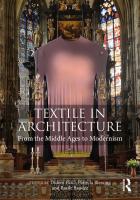Description
This book investigates the interconnections between textile and architecture via a variety of case studies from the Middle Ages through the twentieth century and from diverse geographic contexts.
Among the oldest human technologies, building and weaving have intertwined histories. Textile structures go back to Palaeolithic times and are still in use today and textile furnishings have long been used in interiors. Beyond its use as a material, textile has offered a captivating model and metaphor for architecture through its ability to enclose, tie together, weave, communicate, and adorn. Recently, architects have shown a renewed interest in the textile medium due to the use of computer-aided design, digital fabrication, and innovative materials and engineering. The essays edited and compiled here, work across disciplines to provide new insights into the enduring relationship between textiles and architecture. The contributors critically explore the spatial and material qualities of textiles as well as cultural and political significance of textile artifacts, patterns, and metaphors in architecture.
Textile in Architecture is organized into three sections: "Ritual Spaces," which examines the role of textiles in the formation and performance of socio-political, religious, and civic rituals; "Public and Private Interiors" explores how textiles transformed interiors corresponding to changing aesthetics, cultural values, and material practices; and "Materiality and Material Translations," which considers textile as metaphor and model in the materiality of built environment. Including cases from Morocco, Samoa, France, India, the UK, Spain, the Ancient Andes and the Ottoman Empire, this is essential reading for any student or researcher interested in textiles in architecture through the ages.
Product Details
- Routledge Brand
- Jun 30, 2023 Pub Date:
- 1032250429 ISBN-10:
- 9781032250427 ISBN-13:
- 240.0 pages Paperback
- English Language
- 9.45 in * 0.79 in * 6.69 in Dimensions:
- 1 lb Weight:




